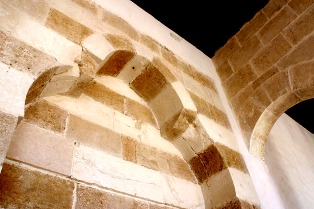An excerpt from the Safar-nama of Nasir Khusraw:
"The city of Acre or Akka “is situated on a rise, and some of the ground is uneven and sloping while other parts are level. Along the coast, they only build towns where there is elevated ground for fear of being inundated by seawater when the waves strike the shore.The Friday mosque is in the middle of the town and is on the highest spot. All the columns are marble.To the right of the Qibla, outside the mosque, is the prophet Salih’s tomb. The courtyard of the mosque is partially paved in stone and partially planted with grass.They say that Adam cultivated that very spot. I measured the city, the length of which was two thousand cubits and the breadth five hundred.The walls are extremely strong, and the Southwestern portion is on the sea.
To the South there is a mina (settlement with tents). Most of the coastal towns have a mina which (operates) as a shipyard. Built right against the town, it has walls out into the water and an open space of fifty ells without a wall but with a chain stretched from one wall to the other. When a ship is about to enter the mina, they loosen the chain so that it goes beneath the surface of the water, allowing the ship to pass over; afterwards the chain is raised again lest stangers make untoward attempts on the ships. To the left of the Eastern gate is a spring, to get to which one must descend twenty-six steps. This spring is called the Cow Spring, and they say that Adam discovered it and watered his cattle from it, whence it derives its name.”
Source: W. Wheeler McIntosh Thackston ed. tr. (2010). Nasir-i Khusraw's Book of Travels. Mazda Publishers, Costa Mesa, CA; p.20.
Acre is a port city on the Southern Syrian coast, which is mentioned in the Bible (Judges 1:31). It was a major military port during Roman times (ca. 9th BCE - 5th CE century). In the early Muslim period, the Umayyad Caliph Mu‘awiya (r. 41AH / 661-680 CE) strengthened Acre's fortifications. He also settled Persians from parts of Muslim Syria in its vicinity. Since then, upto 10th CE century, Acre remained the the main naval-base of the millitary district of Jordan (Jund al-Urdun). After 10th CE century, port Zeila further up the cost in Somalia took its place. In 498 AH / 1104 CE, Acre fell to the Crusaders and quickly became principal port for the Europeans. In 1291, the Mamluk sultan,besieged the town and eventually captured it and razed its fortifications to the ground. By the early- 12th AH / late-17th CE century only a few hundred people lived among its rubble, making a living as fishermen.
Acre during 17th and 18th CE centuries: During 1690-1775 CE, due to the production and trade of cotton, Acre came to play a central role as a trade centre of the region. Large sums of trade revenues were spent in building fortifications, khans (caravanserais), houses, baths, mosques and churches.The growth in trade attracted immigrants to Acre, especially from Cyprus, Damascus, and Mount Lebanon, making it the third-largest city in Bilad al-Sham (the Syrian coastal region). All this made for a very unusual social structure. With Catholic Greeks in majority, Acre came to be an urban society that consisted exclusively of immigrants: void of powerful clans, guilds and crafts organisations and of urban elites (developed over time in other cities) which might have provided effective resistance to the pressure of despotic rulers.
The rapid rise and fall of Acre during this period also intersected with several other developments: the integration of the Syrian coast into the Europe-dominated world economy, the weakening of the central Ottoman power, the concomitant rise of local elites, the rise of the local Arab Greek Catholic community and, finally, the emergence of three very able rulers in Acre. Through cotton trade and a short-lived export of grain, Acre came to be both the first coastal city to be drawn into the world economy dominated by Europe, and also the first to lose its role in that system. During the late Ottoman period, Palestine and the whole Syrian coast experienced rapid urbanisation and economic expansion, but Acre remained remote.
Acre from 19th century onwards: Under the British Mandate in the late 19th and early 20th centuries, Acre expanded very little.The British used the citadel as a major prison and place of executions, hence very little investment capital reached the city.Today Acre consists of two cities: the Arab city intra muros and the new Jewish city extra muros, separated by huge fortifications.
The population numbered about 45,000 in the 1990s, one quarter being Arab. Extensive excavations and reconstruction of the Crusader town have made tourism its single most important industry.
Citation:
Philipp, Thomas, “Acre”. Encyclopaedia of Islam THREE (Brill Online, 2013).
http://referenceworks.brillonline.com/entries/encyclopaedia-of-islam-3/acre-SIM_0186 [accessed July 2013]
Dichter, Bernhard,, Akko: Sites from the Turkish Period (Haifa: University of Haifa. 2000.
Lurie, Yehoshua, Acre -The Walled City: Jews among the Arabs, Arabs among the Jews (Tel Aviv: Yaron Golan Publication, 2000).
Hunsberger, Alice C., Nasir Khusraw, the Ruby of Badakhshan (London, I. B. Tauris, 2000).
Thomas, Philipp, Acre: The Rise and Fall of a Palestinian City 1730–1831 (New York : Routledge 2001).
Petersen, Andrew, A Gazetteer of Buildings in Muslim Palestine: Part 1 (Oxford: Oxford University Press, 2001).
Schur, Nathan, A History of Acre (Tel Aviv: Dvir Publishing House. 1990).

